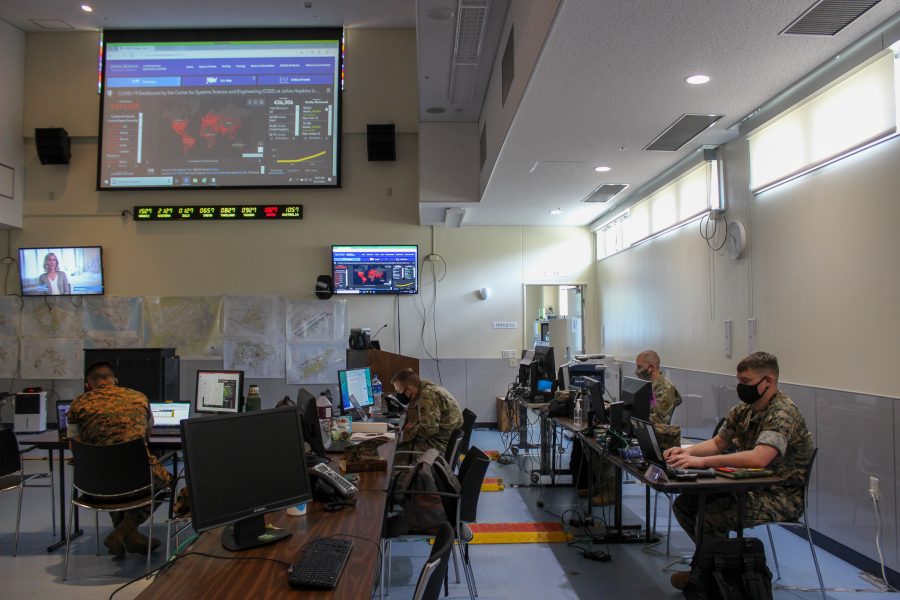OKINAWA, Japan—This tiny island is home to thousands of U.S. troops and their families, with several Marine Corps bases as well as a Navy base, an Army base, and Kadena Air Base. But there’s only one hospital to serve them all: U.S. Naval Hospital Okinawa. So when COVID-19 became a threat in early 2020, the services quickly realized that communication and sharing resources would be critical.
The services began discussions in January, and by late April, the Joint COVID-19 Response Center, or JCRC, was fully operational. The idea of the center is to bring everyone together to make sure they are communicating and using available resources.
“Being out here in Okinawa, we’re limited sometimes, especially if the supply chain is constrained, or with the travel restrictions … so with our services being able to work together, we can actually utilize our resources in a way that helps benefit the greater population of our U.S. forces,” Capt. Brandon Longstreet, the Air Force medical representative for the JCRC, told Air Force Magazine in an interview at the center.
“Each service has their capabilities, and any service by themselves … I think what we’ve learned throughout this is that we can’t do it alone. When we actually work together and everybody pools their resources, their personnel, and their capabilities together, we have what we need to make sure that we can take care of our U.S. population,” he explained.
Okinawa is unique in that it is a joint community without a joint base designation; the commanding general of III Marine Expeditionary Force is the highest ranking U.S. military officer on the island and serves as the “Okinawa area coordinator,” but the top-ranking officials from each of the services, as well as representatives from U.S. government agencies, meet frequently to discuss issues that affect all service members here.
Still, when coronavirus-related restrictions for troops and their families were announced, the rules varied significantly by service branch, leading to confusion and frustration. But that was before the JCRC existed, Longstreet said.
“We didn’t have a structure that allowed us to be able to communicate what the (Health Protection Condition) measures were,” he explained, adding that now, because everyone can get the same information from the JCRC, “when the decision-makers start making decisions, that we’re all fairly even.”
On the medical side, Longstreet said the 18th Medical Group already had a good relationship with the naval hospital, but since the beginning of the pandemic, the two services have worked together even more closely, with the Navy augmenting the Air Force with personnel and the Air Force splitting a shipment of testing kits with the hospital.
That strengthened relationship and increased communication is key, Longstreet said, because “when you’re looking at bed space or facilities, it’s important for us to make sure we’ve got a true picture of what we’ve got on the island.”
While COVID-19 cases climbed in the continental U.S., the number of DOD-related COVID-19 cases here remained very low, with no new cases at all on the island for more than 60 days. Marine 1st Lt. Alyssa Morales, a spokesperson at the JCRC, said officials expect thousands of people to come through Okinawa during the summer moving season, but leaders put preventatives measures in place, the medical facilities have all the supplies they need, and officials are continuously monitoring the situation.
“We’re ready, we’re prepared,” she said.
In late June, Kadena announced it had begun “random surveillance testing” of one percent of Active-duty airmen and DOD civilians every 14 days, as well as 10 percent of the med group’s clinical staff. On July 7, the Marines announced that several people at Marine Corps Air Station Futenma, south of Kadena, had tested positive for COVID-19.
“Although Kadena AB has no cases of COVID-19, your continued diligence in observing all recommended prevention measures will help keep our communities safe,” base officials posted on the Kadena Facebook page.
Longstreet said that if there aren’t a lot of cases, “we did our job.”
And, he added, the communication center can be scaled up or down as necessary, even when it’s no longer needed for COVID-19.
“This whole venture has allowed us to become stronger together as a joint community. One thing that we did not have before is we didn’t know who to talk to, or when to talk to them. We’ve learned a lot about each other, we’ve learned a lot about how the structures work for each one of the services, which makes us stronger,” whether it’s for COVID-19 or for protecting the AOR, he said.
